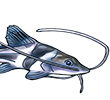Das, D & Nag, TC, 2005. Structure of adhesive organ of the mountain-stream catfish, Pseudocheneis [sic.] sulcatus (Teleostei: Sisoridae). Acta Zoologica 86: 231-237.
Abstract
The structure and ultrastructure of the adhesive organ (AO) in the catfish, Pseudocheneis [sic.] sulcatus (Sisoridae), an inhabitant of the sub-Himalayan streams of India, is described. The surface of the AO is thrown into folds, the ridges of which bear curved spines. The AO epidermis consists of 10â??12 tiers of filament-rich cells, of which the outer tier cells project spines lined with a thick plasma membrane and bear bundles of tonofilaments (TF). Their cytoplasm contains TF and large mucus-like granules, but no obvious organelles. A second tier of living cells with spines is present beneath the outer tier and seems to replace the latter when its spines are damaged or shed. The outer tier cells react positively with antibody to cytokeratin. Actin labelling is clearly absent from the outer tier, indicating that keratinization of the outer tier occurs in the absence of actin filaments. In the cells of the third to fifth tiers, the cytoplasm possesses abundant small mucous granules (0.1â??0.3 µm), and fewer TF compared to the cytoplasm in the spines. The cells of the innermost tiers and the basal layer possess few TF bundles, but no mucous granules. The potential of AO filament cells to produce both mucous granules and keratin filaments is noteworthy. The observations provide evidence that specific regions of fish epidermis can actually undergo a true process of keratinization.
Adhesive apparatus in Pseudecheneis
- Silurus
- Posts: 12420
- Joined: 31 Dec 2002, 11:35
- I've donated: $12.00!
- My articles: 55
- My images: 893
- My catfish: 1
- My cats species list: 90 (i:1, k:0)
- Spotted: 424
- Location 1: Singapore
- Location 2: Moderator Emeritus





